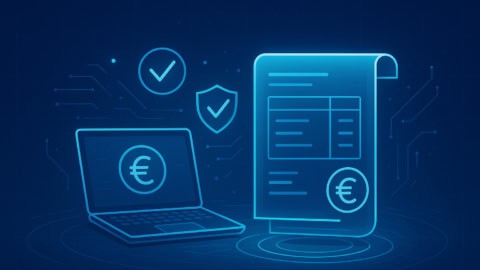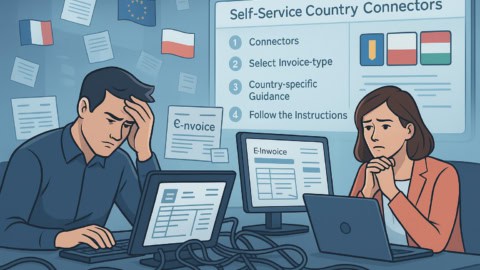In today’s ever-evolving digital landscape, the need for streamlined tax compliance has never been more critical. Enter ViDA – short for “VAT in the Digital Age” – an initiative that promises to revolutionise the way organisations handle Value Added Tax (VAT) and other related transactions. Designed to simplify, standardise, and secure tax processes, ViDA is set to transform the tax compliance landscape and how invoices are handled.
In this article, we’ll explore what ViDA is, why it was launched, the transactions it will affect, the timeline for its implementation, its potential impact, and how IT managers and supply chain executives should prepare.
What is ViDA?
ViDA is a European Commission initiative (published in December 2022) focussed on modernising and digitising the way organisations manage their Value Added Tax obligations. It aims to introduce standardised protocols and encourage the use of cutting-edge digital technologies to streamline tax compliance processes, reduce errors, enhance transparency, and ultimately make the VAT system more efficient for businesses.
Why was the ViDA initiative launched?
Although there are many reasons behind the initiative, the two most significant motivations are reducing losses due to VAT fraud and increasing VAT process efficiency.
Reducing losses
At present, VAT returns processes across the EU are open to manipulation, as transaction reports are typically inspected months after being filed. According to the 2023 VAT Gap Report, EU member states lost an astounding €99 billion in VAT revenues in 2020 alone, with VAT fraud from intra-EU trade thought to be responsible for around a quarter of this total.
The EU Commission has calculated that the transition to universal e-invoicing could reduce VAT fraud by “up to €11 billion” annually, while also shrinking compliance costs for EU traders by “over €4.1 billion per year over the next ten years”.
Increasing efficiency
For businesses that conduct cross-border transactions, handling VAT via the current system can be frustrating and convoluted. By introducing a simplified VAT registration system, promoting real-time digital reporting and mandating e-invoicing, the European Commission hopes to streamline tax processes significantly and make things easier for all involved.
Which businesses and processes will be affected?
What businesses will ViDA affect?
ViDA will affect all businesses that do business with customers in the EU, including online marketplaces and intermediaries that facilitate transactions between others.
Businesses currently lacking the capacity to send and receive e-invoices will be the most affected and will need to adapt their systems quickly in order to gain compliance with upcoming regulations.
What processes will ViDA affect?
When discussing the changes that ViDA aims to instigate, most people refer to the so-called “three pillars of ViDA”, namely single VAT registration, e-invoicing and digital reporting, and the hard-to-define “platform economy”. As far as processes are concerned, however, it is more helpful to think in terms of invoicing, reporting, auditing and VAT registration.
Invoicing
ViDA intends to accelerate the adoption of e-invoicing across all EU member states, resulting in widespread usage by 2030. This acceleration will be enabled by the introduction of e-invoicing mandates by the governments of the countries involved.
Reporting
In addition to increasing the usage and scope of e-invoicing, the ViDA proposal also outlines a plan to introduce Digital Reporting Requirements (DRRs) across all member states from 2030. These DRRs would remove any need for recapitulative statements, requiring businesses to report relevant transactions to a central VIES (VAT Information Exchange System) database instead.
Auditing
If ViDA goes ahead as planned, tax authorities will have improved access to real-time transaction data, enabling more efficient and accurate audits.
VAT registration
ViDA proposals outline a desire to introduce a single VAT registration system. This would allow businesses conducting cross-border transactions in the EU to fulfill all VAT requirements via one portal in a single language. This single VAT registration system is referred to as the import one-stop-shop (IOSS) scheme.
What is the timeline?
ViDA’s implementation will occur in phases, with different regions and countries introducing regulations at varying speeds. Implementation is likely to follow the same path in all countries – namely a pilot program, followed by a staggered roll-out and tiered compliance deadlines based on company size or transaction amount.
While the exact timeline has yet to be agreed by all states at time of writing, the expected timeline is likely to be similar to the below:
2024
- EU countries no longer have to get approval from the European Commission before being able to introduce mandatory e-invoicing.
2026
- At present, any EU business with yearly sales over €10,000 must charge VAT of the customer’s country during cross-border B2C transactions. If annual sales are under €10,000, businesses can collect VAT of their home country. In 2026 it is expected that the directive will be changed to state that only goods dispatched from the seller’s country will count toward this threshold.
- From 2026, cross-border supplies of energy/natural gas may be reported via the One Stop Shop (OSS).
2027
- Platforms offering passenger transport and short-term accommodation (the definition of which will change to <30 days) will be deemed as suppliers unless specifically exempted.
- The “place of supply” of consumer-facing service platforms will be where the transaction takes place.
- EU countries must apply a reverse charge when a non-registered/established seller completes a sale with a customer that has VAT registration in that country.
- The OSS will be expanded to cover cross-border movements of sellers’ own stock.
2030
- Electronic invoices must be issued in a structured format compliant with the European standard (EN16931). Hybrid invoice formats such as ZUGFeRD will be acceptable as long as all requisite data is included in a structured format.
- E-invoices will be mandatory for all transactions falling under the Digital Reporting Requirements (DRR).
- Customers will not be required to accept non-automated invoicing.
- Being able to accept electronic invoices may become a necessary condition in order to claim back VAT.
- E-invoices must be issued within ten days of DRR transactions.
- Summary invoices can be issued up to ten days after the end of the month in which the relevant sales were made.
- Recapitulative statements will be replaced with more effective anti-fraud measures.
- Invoices must include bank account numbers.
- Reporting will become mandatory for zero-rated sales, intra-EU acquisitions, and cross-border transactions under the reverse charge mechanism.
- EU-compliant DRR may be implemented by EU countries for domestic sales.
- It will no longer be necessary to submit EC sales lists (AKA ESLs) for intra-EU sales.
2035
- By 2035, all existing domestic e-reporting systems must be in-line with the EU standard.
For a full breakdown of ViDA’s proposed deadlines, see the EU Commission’s final report (four volumes).
Postponements
On 16 June 2023, the EU Parliament Committee on Economic and Monetary Affairs (ECON) voted on and approved a report proposing a one year delay for all of ViDA’s main three pillars (single VAT registration, e-invoicing and digital reporting, and the platform economy). However, following a recent meeting, it was confirmed that sign-off on the suggested reforms will not happen until 2024.
As a result, the proposed deadline for the EU-wide implementation of e-invoicing and digital reporting looks set to move back to at least 2030 (with some suggesting the deadline may be pushed back to 2032). Meanwhile, the postponement also throws doubt on the proposed deadlines relating to VAT registration processes.
On Tuesday 14 May 2024 updated ViDA proposals were discussed by the Economic and Financial Affairs Council configuration (ECOFIN). Unanimous agreement was not reached in the meeting, however, as Estonia expressed opposition towards the deemed supplier regime, asserting that further work would be required in order to safeguard SMEs and private consumers.
What impact will ViDA have?
For many businesses, ViDA will mean implementing new processes and software in order to comply with changing requirements. While this may initially be costly, it also presents an opportunity to step back, reassess your B2B strategy, and build a more resilient e-invoicing solution.
In fact, aside from complications associated with implementation, the impact of ViDA is expected to be extremely positive for businesses, governments, and the public alike.
For businesses, streamlined processes and reduced manual workloads will result in increased operational efficiency. Likewise, the digitisation of VAT processes will boost accuracy by minimising errors and discrepancies. Over time, too, reduced administrative overhead and fewer compliance-related errors should result in considerable cost savings.
For authorities the benefits will be much the same. With real-time access to transaction data, tax authorities will benefit from more efficient and transparent systems and should be able to massively reduce VAT fraud.
For the public the increase in VAT revenue should mean more money for governments to spend on public projects. For example, the amount of VAT revenue not collected by EU countries in 2020 alone could have funded a 1,700 km high speed railway line from Berlin to Bucharest!
But there’s no need to speculate. Thanks to research by the European Commission, it is already possible to see the impact that the recent increase in automated processes has had on VAT revenue across Europe. According to the latest report, in just one year between 2020 and 2021, the overall VAT gap decreased by around €38 billion thanks largely to the increase in automated invoicing processes!
What should you do to prepare?
As no two businesses are in the exact same position, there is no “one size fits all” approach when it comes to preparing for ViDA. However, there are are several things you can do to improve your preparedness:
- Stay informed: By staying on top of developments regarding ViDA’s implementation, you will have time to plan your strategy and will avoid the dangerous situation of rushing to update your system before an imminent deadline.
- Assess existing systems and resources: Take the time to fully evaluate your existing systems, processes and internal resources. Identify what is required to support ViDA’s digital requirements and where possible weak points may be before deciding on a solution.
- Consider all your options: Just because you have handled all B2B messaging in-house previously, this doesn’t mean you have to do so moving forward. For many businesses, the simplest and most cost-effective way to achieve compliance with ViDA requirements is to enlist the help of an external solution provider. At ecosio, for example, we take care of all e-invoicing tasks for our clients, leaving them free to focus on what they do best.
Conclusion
ViDA represents a significant transformation in VAT and tax compliance, and promises to streamline processes, reduce errors and enhance transparency. In order to be able to appreciate these benefits, however, it is important for businesses to prepare. By making sure your systems and processes align with ViDA’s digital requirements before mandatory regulations are introduced, you can enjoy stress-free compliance while maximising the advantages of automated processes for longer.














